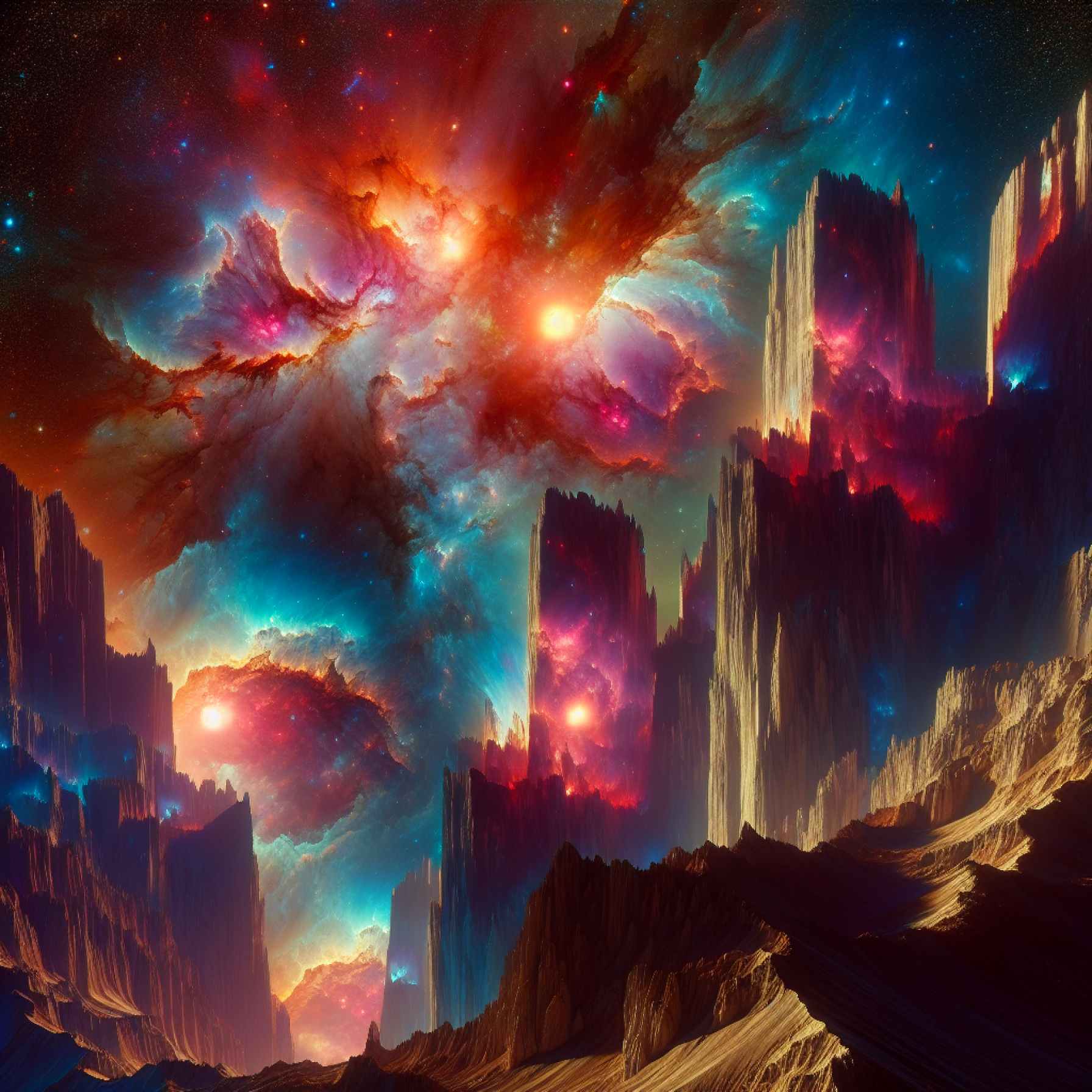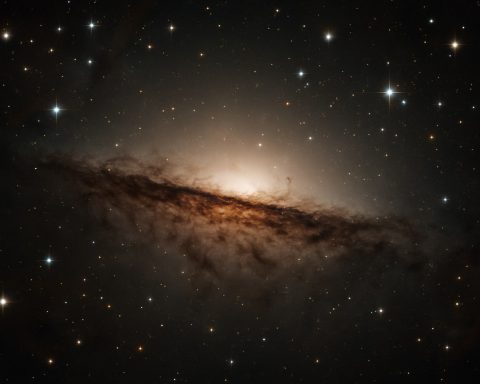- The Cosmic Cliffs in the Carina Nebula Complex are brought to life through an awe-inspiring 3D visualization enabled by recent technological advancements.
- These celestial formations, comprised of gas and dust, are sculpted by ultraviolet radiation and stellar winds from the young star cluster NGC 3324.
- The visualization is a collaboration of data from the James Webb Space Telescope along with Hubble, Spitzer, and Chandra observatories, offering a captivating cosmic fly-through experience.
- This innovative depiction reveals dynamic features such as protostellar jets, hot ionized gas, and the monumental scale of the Cosmic Cliffs.
- The project by NASA’s Universe of Learning helps bridge the gap between human perception and the universe, encouraging viewers to reflect on the cosmos and humanity’s place within it.
The grandeur of the universe unfurls like a cosmic tapestry in an awe-inspiring transformation of the Cosmic Cliffs, a celestial marvel residing within the Carina Nebula Complex. Recent technological advancements have breathed new life into this enchanting nebula, with the release of a captivating 3D visualization that transports viewers to the heart of this astronomical wonder.
Nestled some 7,600 light-years away, the Cosmic Cliffs rise majestically like mountainous sentinels, yet these celestial formations are neither stone nor earth. Instead, they are colossal walls of gas and dust, sculpted by the potent ultraviolet radiation and stellar winds emanating from the stars of NGC 3324. This young star cluster, residing in the Gum 31 nebula, plays the part of a celestial artist, chiseling away the interstellar medium to reveal the vibrant beauty of newly-formed stars.
This innovative visualization is a product of NASA’s Universe of Learning project and draws from the unparalleled clarity and detail of data gathered by the trailblazing James Webb Space Telescope alongside archival information from Hubble, Spitzer, and the Chandra X-ray Observatory. Together, they weave a mesmerizing fly-through experience that breaks the confines of traditional two-dimensional depictions.
Picture this: Immense dust pillars that pierce the cosmic landscape, protostellar jets that dance through the ether in vibrant yellow arcs, and streams of hot, ionized gas swirling like mystical mist through the nebula. Bright jets from young stars punctuate the vista, tracing their outflows through the galactic expanse. The 3D model unveils a cosmos where the scale is staggering, paint-brushed by forces of unimaginable strength.
Standing on one of these celestial peaks would render Earth’s tallest mountains mere anthills by comparison. Here in the stars, the inexorable power of young stars’ radiation erodes the cosmic cliffs, a relentless sculptor shaping these intricate formations over eons.
For the public, this visualization is not just an educational tool—it’s an invitation to journey through the universe with new eyes. It bridges the gap between our earthly senses and the vast intricacies of space, fostering a deeper connection and understanding of the universe’s architecture.
Through this vivid portrayal, viewers are inspired to ponder not just the distant reaches of the cosmos but also humanity’s place within it. As the cosmic cliffs come alive in three dimensions, they serve as a testament to the ongoing dance of creation and destruction that defines our universe—a dance that, through tools like this visualization, we are only just beginning to truly appreciate.
Cosmic Cliffs: The Extraordinary 3D Visualization Unlocking the Universe’s Secrets
Expanding Our Understanding: Cosmic Cliffs in the Carina Nebula Complex
The Cosmic Cliffs is a captivating region within the Carina Nebula Complex that has recently been brought to life through a groundbreaking 3D visualization. This immersive experience is a collaboration between NASA’s Universe of Learning project and data from advanced telescopes such as the James Webb Space Telescope, Hubble, Spitzer, and the Chandra X-ray Observatory. As we journey into this celestial marvel, let’s delve deeper into aspects that may not have been fully explored in initial discussions.
The Carina Nebula: A Birthplace of Stars
Situated approximately 7,600 light-years from Earth, the Carina Nebula is one of the largest and most active star-forming regions in our galaxy. It provides a unique window into the processes that shape new stars and planetary systems. Within its boundaries lies the young star cluster NGC 3324, which acts as the sculptor of the Cosmic Cliffs, with its stellar winds and ultraviolet radiation carving intricate patterns into the gas and dust.
Technological Marvels: The Role of Advanced Telescopes
The data used to create the 3D visualization combines observations from both past and present missions.
1. James Webb Space Telescope: It offers unprecedented infrared imagery, revealing hidden details of star birth beneath the dusty shrouds.
2. Hubble Space Telescope: With its high-resolution optical and ultraviolet capabilities, Hubble provides complementary data, showcasing dynamic processes like star formation.
3. Spitzer Space Telescope: Though no longer in operation, its infrared data continues to inform our understanding of the nebula’s cooler regions.
4. Chandra X-ray Observatory: By examining energetic phenomena, such as the interactions of stellar winds, Chandra adds a critical layer of insight.
Step-by-Step: How to Access and Explore the 3D Visualization
1. Visit NASA’s Universe of Learning website: NASA regularly updates their website with the latest educational resources.
2. Locate the Cosmic Cliffs Visualization: Look for sections dedicated to the Carina Nebula or the James Webb Space Telescope.
3. Engage with Interactive Features: Use the fly-through feature to explore the nebula’s intricate details at your own pace.
Real-World Implications and Science Advancements
The Cosmic Cliffs visualization serves several purposes beyond fascination:
– Educational Opportunities: It provides an engaging tool for teaching concepts of astronomy and physics.
– Inspiring Future Explorers: By visualizing the grandeur of the universe, people are motivated to learn more about science and technology fields.
– Research Applications: Astronomers use such visualizations to hypothesize and test models of cosmic phenomena.
Market Forecasts & Industry Trends
The development of such visualizations signals a growing trend in using augmented reality (AR) and virtual reality (VR) technologies for educational purposes. These tools can create impactful experiences in classrooms, museums, and public outreach centers. As VR technology improves, expect more detailed and interactive cosmic simulations.
Limitations and Challenges
While current technologies allow for detailed 3D models, limitations still exist:
– Data Resolution: Even with advanced telescopes, resolving small-scale features remains a challenge.
– Computational Requirements: Creating and rendering such models require significant computational power.
– Interpretation: Visualizations are artistic representations and may sometimes simplify complex scientific data.
Actionable Recommendations
1. Engage with Education Tools: Besides visualizations, consider using online platforms for astronomy courses and lectures.
2. Enhance DIY Astronomy: Apply what you learn by using telescopes for skywatching.
3. Stay Informed: Follow advances in space telescopes like the James Webb for the latest discoveries.
Keywords
– Cosmic Cliffs
– Carina Nebula Complex
– 3D Visualization
– James Webb Space Telescope
– Stellar Formation
For more information, visit the NASA website.
By leveraging technology and creativity, humanity continues to bridge the vast expanse of space, turning the distant reaches of the cosmos into concrete steps towards knowledge and discovery.












